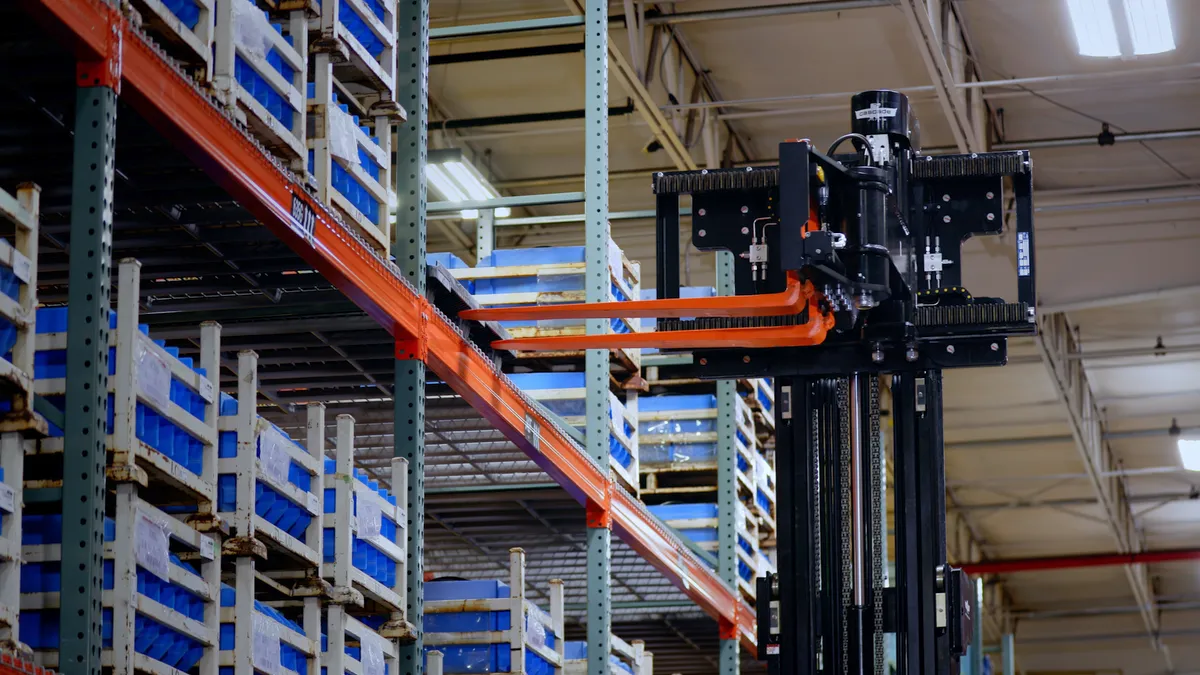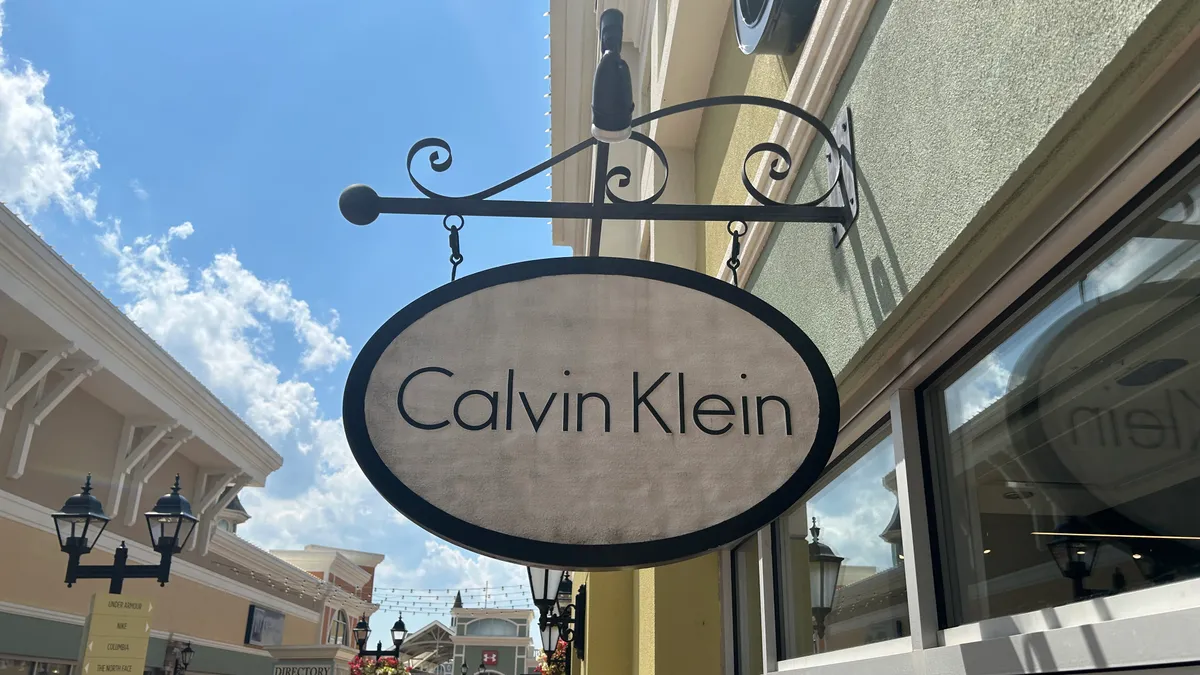Something as simple as adopting a new type of forklift can help a company adapt for shifting e-commerce trends. And it's just one technological innovation that retail and e-commerce warehouse operators are using to keep up with rising consumer demand.
The daily ballet of fork trucks lifting pallets into warehouse racks could become more elegant with a new ambidextrous forklift.
Instead of fork trucks turning in the aisle to face the pallets, the Toyota Core Electric Turret Forklift drives along the aisle, parallel to the racks. The fork attachment pivots 180 degrees from side to side, so it can reach racks on either side of the aisle without turning.
That saves a lot of backing up for forklift drivers. It also means the aisle can be reconfigured from a standard 12 to 13 feet to a very narrow aisle set up of 7 feet wide.
The very narrow aisle option is becoming more popular, because it can yield two additional rows for every 10 rows of a traditional wide aisle, said David Morzella, a territory manager for Toyota Material Handling, headquartered in Columbus, Indiana.
"This solution allows customers to reduce their aisle widths, add more racks, and drastically increase the storage capacity and overall volume of their operations,” he said.
The turret is mated to a standard, electric driver-down forklift unit with an attachment that pivots the forks from the center of the mast. It's designed for pallet-in, pallet-out operations with a sweet spot of up to a 2,500-pound load, 20-foot reach for standard 48 by 40 pallets, Toyota said in a press release.
The pivot forklift is suited for finished-goods storage and raw materials in manufacturing plants, where there's warehouse space connected to the factory floor to store products.
"As the company grows, that space becomes more critical. And so, if they wanted to use the space better, this would be a big gain for them," Morzella said.
The evolving warehouse
The forklift is more expensive and slower than a reach truck or order picker, Morzella said, so it's not usually used for picking operations. But it allows the warehouse to move pallet loads from the dock to the racks with one vehicle.
Configuring a warehouse for a very narrow aisle set up is just one way companies are rethinking how to make the most out of their space.
Operators are looking to technology innovations to help address the labor crunch and to transform warehouses into more adaptable platforms to support e-commerce, said Tray Anderson, logistics and industrial service lead, Americas, for commercial real estate services firm Cushman & Wakefield.
"With technology advancements, the investments in material-handling equipment and automation can exceed the cost of the building's shell."

Tray Anderson
Logistics and Industrial Service Lead, Americas, for Cushman & Wakefield
Even the basic warehouse shell has evolved in recent years, as clear ceiling heights have grown from 32 feet up to 90 feet. "With technology advancements, the investments in material-handling equipment and automation can exceed the cost of the building's shell," he said.
Given the rapid shift toward e-commerce during the pandemic, companies are looking for solutions that will allow warehouse operations to be flexible rather than installing a massive, fixed solution.
"A forklift is going to be more nimble than a goods-to-person system designed for specific product dimensions and order profiles that could change very quickly," Anderson said.
Kenco, a Tennessee-based provider of third-party logstics, has adopted robotic solutions that allow it to retrieve goods faster and reduce labor while still completing value-added processes. For example, shippers want to customize their shipments with branded packaging, personalized inserts and new product bundles, said Dan Coll, vice president of e-commerce fulfillment.
Some digitally native brands are moving into brick-and-mortar retail and need scalable, flexible fulfillment options. At the same time, traditional brick-and-mortar consumer retailers, as well as those in the business-to-business segment, are ramping up e-commerce channels. Those traditional companies are typically set up to handle cases and pallets, not individual orders.
"What we have found is no merchants have the exact same needs," Coll said.
Shippers are tapping 3PLs for multi-tenant distribution centers that have a higher level of automation than the company could afford on its own. Micro-fulfillment centers within a 3PLs distribution center use proven automation technology and allow a company to scale as needed, Coll noted.
The appeal and fear of automation
Automation is showing up for work every day. Boston-based Locus Robotics reported its robots have performed more than 300 million product picks in warehouses globally.
“Fulfillment warehouses were already grappling with labor shortages amid steady e-commerce growth, and were looking to improve productivity,” said Rick Faulk, CEO of Locus Robotics. “The pandemic has created a greater sense of urgency and prompted more warehouse operators to jump on the path to digital transformation sooner than they might otherwise have contemplated – not only for improved productivity and business insights, but also for the benefits of greater worker safety and social distancing. Warehouses can no longer wait to deploy flexible, intelligent automation.”
Some companies that thought they were set up for omnichannel retail found their supply chain stressed during the pandemic, as demand rapidly shifted from retail to online sales. It was more difficult than they thought to locate and use inventory between online and in-store channels.
Kenco is using visibility technology and predictive analytics, so shippers can direct inventory to the most likely sales channel. The retailer can identify the store with the product closest to the consumer and offer in-store pick up, ship from store, or ship for home delivery.
"There's a lot of focus in the market right now on solving for what is true omnichannel and having a single source of availability for inventory," Coll said. "Retailers with a real-time view across their inventory can make predictive decisions for inbound stock so that it's placed in the channel which the customer is mostly likely to use."
The Holy Grail of automation is the dark warehouse that operates without human hands involved. Ocado's Smart Platform technology that Kroger is adopting for grocery fulfillment comes close, but that level of automation doesn't add up for most warehouse operators.
"The technology is astronomically expensive. And you have the problem of knowing what your business is going to look like in the years to come, and manufacturers and retailers do not know that," said Kristi Montgomery, vice president and head of Kenco's Innovation Labs.
"Warehouses can no longer wait to deploy flexible, intelligent automation."

Rick Faulk
CEO of Locus Robotics
After experiencing the volatility during the pandemic, companies are reluctant to commit to 10-year automation plan that requires a significant capital investment.
"Our customers want to address the labor issue with automation but they want to have an automation fleet that can adapt to workflow changes," said Montgomery. "They're looking to scale up automation on an as-needed basis."
Montgomery added: "We're seeing robots with form factors that can handle cases and eaches, and have the ability to optimize around the workflow."
Perhaps the biggest barrier to adoption is the massive glut of technology options in the marketplace. Kenco set up its Innovation Lab to test devices and approaches to advise customers on the best solutions, given its product and order profiles.
"There's a lot of fear of picking the wrong thing and spending a lot of money on robotics, and it doesn't work out," Montgomery said.
This story was first published in our weekly newsletter, Supply Chain Dive: Operations. Sign up here.





















